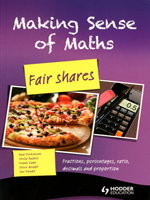Making Sense of Maths: Student's Book. Fair Shares
By Paul Dickinson, et al.
June 2012
Hodder Education
Distributed by the Trans-Atlantic Publications
ISBN: 9781444169089
60 Pages, Illustrated
$19.95 Paper original
Making Sense of Maths is the only series that develops conceptual understanding.
This series will motivate, engage and develop the conceptual understanding of students at KS3 and KS4.
Students build their own problem solving strategies based on their understanding of the world around them which then support them to tackle functional questions.
The Student's Book, used in conjunction with the workbook and teachers' book, provides engaging activities that support students in developing a true understanding of fractions, percentages, ratio and proportion.
Making Sense of Maths has been based on Realistic Maths Education (RME) and extensively trialled in KS3 and KS4 classrooms in the UK by a team from Manchester Metropolitan University.
- Use alongside existing resources or on its own
- Ideal for Year 10s heading for the C/D borderline
- Ideal for intervention groups
- Supports the move from modular to linear specifications by improving knowledge retention
- Provides support for good teaching and learning under the current Ofsted criteria
- Builds confidence and motivation
- Addresses misconceptions
- Each title covers a different set of topics
Table of Contents:
![]() Introduction
Introduction
![]() Chapter 1: Fractions
Chapter 1: Fractions
![]() Work experience
Work experience
![]() Pablo's pizzas
Pablo's pizzas
![]() Coley the cutter
Coley the cutter
![]() Pizza fractions
Pizza fractions
![]() Summary
Summary
![]() Chapter 2: Percentages
Chapter 2: Percentages
![]() Downloading programs
Downloading programs
![]() Going to the bank
Going to the bank
![]() Test results
Test results
![]() Depreciation
Depreciation
![]() Summary
Summary
![]() Chapter 3: Ratio
Chapter 3: Ratio
![]() What's in a necklace?
What's in a necklace?
![]() The jewellery company
The jewellery company
![]() Expanding the business
Expanding the business
![]() Unthreaded necklaces
Unthreaded necklaces
![]() Pablo's pizza parlour
Pablo's pizza parlour
![]() Using the bar model for ratio problems
Using the bar model for ratio problems
![]() Who is the fastest of them all?
Who is the fastest of them all?
![]() World record speeds and beyond?
World record speeds and beyond?
![]() Animals on the motorway
Animals on the motorway
![]() Jewellery prices
Jewellery prices
![]() Buying electrical goods in America
Buying electrical goods in America
![]() Summary
Summary
![]() Chapter 4: Multiplication and division
Chapter 4: Multiplication and division
![]() Martha making sense of multiplication
Martha making sense of multiplication
![]() Does multiplication make the answer bigger?
Does multiplication make the answer bigger?
![]() Multiplying fractions
Multiplying fractions
![]() Understanding division
Understanding division
![]() Does division make the answer smaller?
Does division make the answer smaller?
![]() Mixing it up
Mixing it up
![]() Summary
Summary
Return to main page of Trans-Atlantic Publications